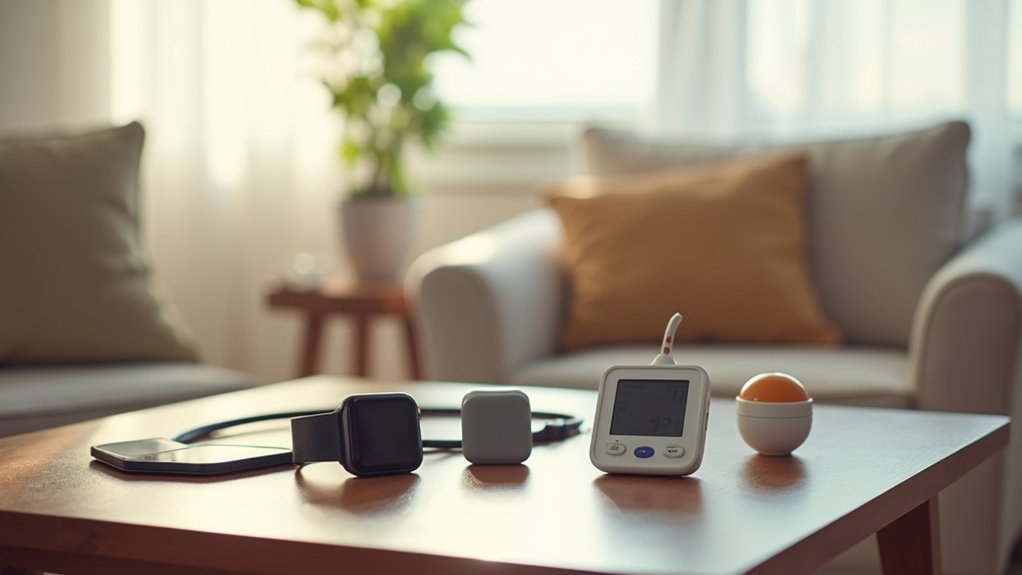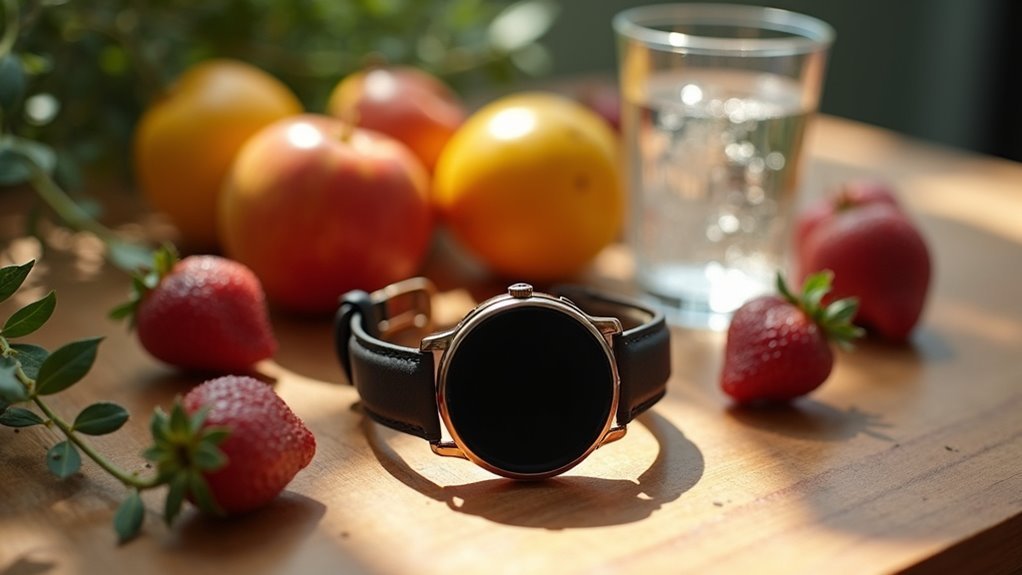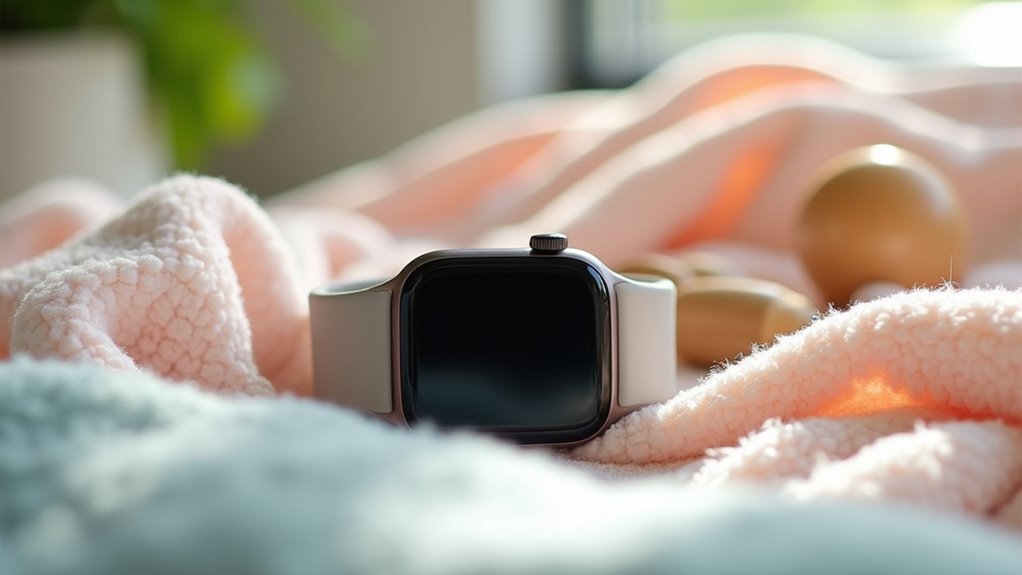You’ll find the right senior health monitoring device by choosing models with large, high-contrast displays and simple interfaces that reduce confusion. Prioritize automatic fall detection with GPS tracking and two-way communication for emergency response. Select devices offering extended battery life like ScanWatch 2’s 30-day power or budget options starting at $35. Guarantee medical-grade accuracy for heart monitoring and seamless smartphone integration for family caregivers. These essential features will guide you toward discovering all-encompassing safety solutions.
Choose Devices With Simple, Large Display Interfaces
Since visual clarity becomes increasingly important with age, selecting health monitoring devices with simple, large display interfaces should be your top priority.
You’ll want devices featuring extra-large, high-contrast displays that reduce eye strain and enhance readability. Look for clear, bold fonts with adjustable text sizes to accommodate your visual needs.
Choose devices with anti-glare screens for better visibility in bright environments, and backlit displays for comfortable nighttime viewing.
Simple, uncluttered home screens displaying essential information prominently will improve your navigation experience and reduce confusion. Prioritize devices with intuitive design to avoid overly complex technology that can hinder independent operation.
Ensure your device offers adjustable color schemes and contrast settings so you can personalize the display for ideal visibility.
These features make monitoring your health data considerably easier and more comfortable.
Prioritize Automatic Fall Detection With GPS Tracking
While clear displays help you monitor your health data effectively, automatic fall detection with GPS tracking provides immediate protection when emergencies strike.
Clear health displays matter, but automatic fall detection with GPS tracking delivers life-saving emergency protection when you need it most.
You’ll want devices that combine accelerometers, gyroscopes, and barometric sensors to accurately detect falls while minimizing false alarms from normal movements like gardening or walking.
Look for systems with AI-powered algorithms that distinguish between actual falls and routine activities. GPS integration guarantees emergency responders can locate you anywhere, whether you’re at home or outdoors.
Two-way communication features let you speak directly with monitoring centers through built-in microphones and speakers.
Consider pendant or belt-worn devices over smartwatches since they offer higher accuracy with fewer false alarms. Chest-worn devices demonstrate the highest reliability with a 98% accuracy rate for fall detection.
Water-resistant models work in bathrooms where many falls occur, providing thorough protection throughout your daily activities.
Select Monitors With Extended Battery Life and Minimal Charging
You’ll want to compare battery performance across different devices since frequent charging can become a daily hassle that discourages consistent use.
Look for monitors offering week-long or month-long battery life, as these low-maintenance options reduce the burden of remembering to charge your device regularly. Some advanced systems like LifeFone’s VIPx mobile device feature 10-day battery capabilities, providing extended independence between charges.
Consider devices with power-saving features like voice activation or simplified monitoring functions that extend battery life without sacrificing essential health tracking capabilities.
Battery Life Comparison
When choosing health monitoring devices for seniors, battery life becomes a critical factor that directly impacts daily usability and peace of mind.
The ScanWatch 2 leads with an impressive 30-day battery life, making it ideal if you tend to forget charging routines.
For medical alert systems, the LifeFone VIPx offers 10 days of reliable power with GPS tracking and fall detection capabilities.
Medical Guardian provides up to 5 days of battery life with extensive alert features.
The Aloe Care Mobile Companion delivers extended fall detection monitoring, while Bay Alarm Medical includes robust backup battery systems.
The Lively Wearable 2 stands out with an exceptional 120-day battery life, making it one of the most convenient options for seniors who want minimal charging maintenance.
You’ll find that devices with longer battery life reduce maintenance stress and guarantee continuous health monitoring, especially during travel or emergencies when charging isn’t convenient.
Low Maintenance Options
Since charging devices regularly can become a challenging task for seniors, selecting monitors with extended battery life markedly reduces daily maintenance demands.
You’ll find devices like the ScanWatch 2 offering up to 30 days of battery life, while the LifeFone VIPx provides 10 days of continuous use. These extended batteries guarantee you won’t worry about power outages or forget charging routines.
You’ll benefit from increased independence and reduced stress when your device requires minimal maintenance. Device manufacturers implement verification steps to ensure only accurate health data reaches emergency contacts and healthcare providers.
Look for monitors that combine long battery life with essential features like GPS tracking and fall detection. The Aloe Care Mobile Companion excels in fall detection modes with extended power, while Bay Alarm Medical offers robust backup systems.
Choose devices that prioritize ease of operation alongside extended battery performance.
Power Saving Features
Three critical power-saving features separate the most effective senior health monitors from standard alternatives.
First, you’ll want devices offering extended battery life—the ScanWatch 2 provides up to 30 days per charge, while medical alert systems like LifeFone and VIPx deliver 10 days of continuous operation.
Second, look for automatic power-saving modes that deactivate non-essential features when battery drops below 10%, extending usage time during critical moments.
Third, choose monitors with fast charging capabilities; the ScanWatch 2 recharges completely in two hours, minimizing downtime. In contrast, devices like the Apple Watch Series 10 require daily charging due to their 18-hour lifespan, making them less practical for seniors who may forget regular charging routines.
These energy-efficient designs focus on core health metrics rather than unnecessary features, ensuring your device remains functional when you need it most while reducing charging frequency.
Opt for Medical-Grade Heart and Vital Sign Monitoring
Medical-grade heart and essential sign monitoring devices deliver the accuracy and reliability that standard consumer wearables can’t match, making them indispensable tools for seniors managing cardiovascular conditions. These devices provide continuous data collection over extended periods, capturing critical health indicators that might otherwise go unnoticed.
| Device Type | Key Features | Best For |
|---|---|---|
| Holter Monitors | 24-48 hour continuous ECG | Detecting irregular rhythms |
| NUVANT Mobile Cardiac Telemetry | Real-time arrhythmia monitoring | Active seniors needing flexibility |
| Zio Patch | 14-day offline cardiac analysis | Long-term heart activity tracking |
| Multi-Parameter Monitors | Heart rate, blood pressure, temperature | Thorough health surveillance |
You’ll benefit from devices with enhanced P-wave sensitivity and customizable alerts that notify caregivers immediately when irregularities occur, ensuring prompt medical intervention. Modern cardiac monitoring solutions offer waterproof capabilities that allow seniors to maintain active lifestyles, including swimming and exercise, without compromising the continuous monitoring of their heart health.
Ensure Smartphone App Integration for Family Caregivers
High-tech monitoring equipment becomes truly powerful when paired with smartphone apps that connect your entire care network.
You’ll want devices that automatically sync essential signs, blood pressure readings, and other health data directly to family members’ phones in real-time. Look for apps offering instant alerts when readings fall outside normal ranges, plus secure messaging channels for care coordination.
Choose systems with intuitive interfaces that don’t require technical expertise from older users. Confirm the app supports multiple caregiver accounts and provides HIPAA-compliant data protection.
Prioritize user-friendly systems that elderly users can navigate easily while ensuring robust security and multi-caregiver access capabilities.
The best platforms integrate with wearables, export data for doctor visits, and offer shared calendars for medications and appointments. Modern solutions also include GPS tracking capabilities that allow families to monitor their loved one’s location and ensure their safety throughout the day. This connectivity reduces missed communications and gives everyone peace of mind through centralized health information.
Compare Cost-Effective Options With Essential Health Features
You don’t need to break the bank to get essential health monitoring features that’ll keep you safe and connected to your caregivers.
Smart shopping means identifying which features you actually need—like fall detection and GPS tracking—versus premium add-ons that mightn’t justify their extra cost.
The key is finding devices that balance affordability with the core safety features that matter most for your specific lifestyle and health needs. Many quality systems can be set up in under 10 minutes in your home, making the transition to health monitoring surprisingly straightforward.
Budget-Friendly Essential Features
While premium health monitoring devices often come with hefty price tags, budget-friendly options deliver essential safety features without breaking the bank. You’ll find devices starting around $35 upfront with monthly monitoring fees near $35, making them accessible for most seniors on fixed incomes.
| Feature | Budget Models | Premium Models |
|---|---|---|
| Emergency SOS | 24/7 monitoring included | 24/7 monitoring included |
| GPS Tracking | Basic location services | Advanced mapping features |
| Activity Monitoring | Step counting, basic metrics | Extensive health analytics |
These cost-effective devices prioritize core safety functions like emergency response and GPS location tracking. You won’t get smartphone pairing requirements, which reduces complexity and costs. Many include fall detection as either standard or upgrade options, while clear interfaces with large icons guarantee you can operate them independently without technical difficulties. The Spade & Co Health Smartwatch 3 stands out for its minimal learning curve, making it particularly suitable for seniors who want health monitoring without complexity.
Value Vs Premium Options
When choosing between value and premium health monitoring devices, the decision often comes down to whether advanced features justify notably higher costs.
Premium options like Apple Watch Series 9 (£359-£399) offer extensive health tracking including ECG, blood pressure, and SpO2 monitoring, plus 24/7 professional monitoring services. However, monthly subscriptions add £10-£40 ongoing costs.
Mid-range alternatives like Bay Alarm Medical SOS Smartwatch (£159 plus subscription) provide essential safety features—heart rate monitoring, GPS tracking, and fall detection—without premium pricing. You’ll sacrifice advanced health metrics but retain core emergency functionality.
Consider your specific needs: if you’re managing chronic conditions, premium devices offer valuable health insights.
For basic safety monitoring, value options deliver essential protection at notably lower costs while maintaining user-friendly interfaces designed for seniors. True medical alert smartwatches feature built-in cellular SIM cards that eliminate the need for smartphone pairing, making them particularly accessible for seniors who prefer simpler technology setups.
Verify Multi-Platform Compatibility and Emergency Response Systems
Since modern health monitoring devices must work seamlessly across different platforms and respond reliably during emergencies, you’ll need to carefully evaluate both compatibility features and emergency response capabilities before making your selection.
First, verify the device integrates with existing wearables and caregiver apps while supporting both Android and iOS smartphones. Ascertain it offers Wi-Fi and cellular connectivity for reliable data transmission, and check that apps are available on both App Store and Google Play Store.
For emergency response, prioritize devices offering immediate fall alerts, two-way communication, and automated medication reminders.
Look for systems providing live video access and reliable customer support. Choose devices with customizable notifications based on your senior’s specific needs, real-time health updates, and smart alerts that distinguish between critical and non-critical situations. Consider systems that monitor temperature changes within the home to detect potential health risks or environmental hazards.
Frequently Asked Questions
Can Health Monitoring Devices Work Without Internet or Cellular Connection?
You can use basic health monitoring devices like heart rate monitors and pedometers offline since they store data locally. However, you’ll lose real-time alerts and remote monitoring capabilities without internet connectivity.
How Accurate Are Consumer-Grade Health Monitors Compared to Hospital Equipment?
Consumer-grade health monitors aren’t as accurate as hospital equipment. You’ll find they’re moderately reliable at rest but less precise during movement. Hospital devices undergo rigorous testing and FDA approval for clinical accuracy.
What Happens to Stored Health Data if the Device Breaks?
Your health data stays protected through encrypted cloud backups and secure server storage. You’ll retain access even if your device breaks, and manufacturers provide recovery procedures to restore your information seamlessly.
Do Insurance Plans Cover Senior Health Monitoring Device Costs?
You’ll find coverage varies greatly between plans. Medicare Part B covers some remote monitoring devices, while private insurers typically cover medically necessary items like blood pressure monitors through prior authorization.
Can Multiple Family Members Receive Alerts From One Device Simultaneously?
Yes, you can set up multiple family members to receive alerts simultaneously from one device. Most systems let you customize who gets notified and what type of alert they’ll receive based on their caregiving role.





Leave a Reply